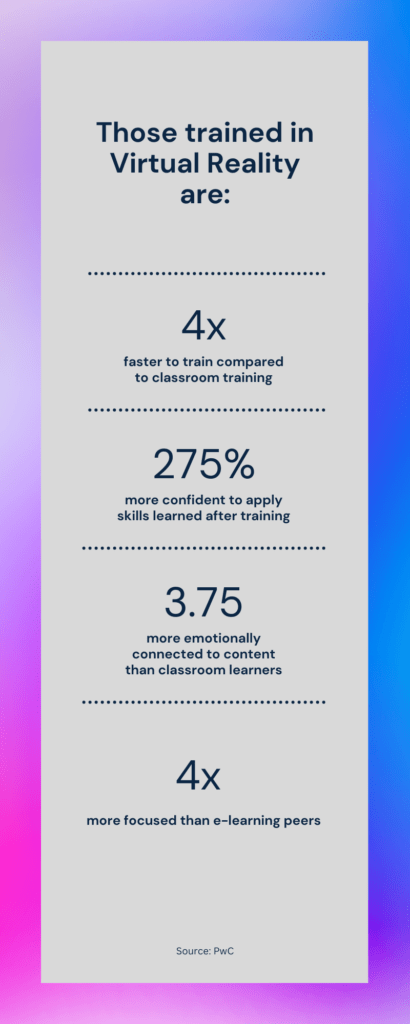Virtual reality (VR) technology has been gaining popularity in recent years as a tool for training and education. One of the main advantages of VR training is its cost-effectiveness when compared to traditional training methods. In this article, we will explore the benefits of VR training and examine how it compares to traditional employee training when it comes to saving costs.
One of the first things to consider adapting VR training for your organization is how it affects employee training beyond cost savings. Learning skills in virtual reality offers a unique and immersive way to simulate real-world scenarios, making it an ideal tool for hands-on training in fields such as healthcare, aviation, and construction. Through VR technology, your employees can safely practice procedures and techniques in a controlled environment, without putting themselves or others at risk. This, combined with the ability to customize VR training to fit the specific needs of each trainee or your company, makes it a highly personalized and effective method of training.

Cutting Costs and Improving Efficiency with Virtual Reality Training
Virtual reality training has been proven to be an effective method for a variety of industries, but one of its biggest advantages is cost savings. By using VR, companies can save money on traditional training methods such as travel expenses, equipment costs, and instructors. VR training also allows for simulations of real-world scenarios, reducing the need for expensive and potentially dangerous on-the-job training.
Travel expenses
One of the biggest expenses associated with traditional employee training is the cost of travel. Employees may need to travel to a physical location for training, which can add up in terms of travel expenses such as airfare, hotel accommodation, and transportation. This not only increases the overall cost of training but also results in lost work time for employees. Virtual reality training, on the other hand, can be done remotely, eliminating the need for travel. This means employees can participate in training from anywhere, saving both time and money.
Facility costs
Another significant expense associated with traditional training is the cost of renting or maintaining physical training facilities. This includes classrooms, training rooms, and any specialized equipment or materials that may be required. In contrast, virtual reality training can be done in a virtual environment, eliminating the need for physical facilities. This means companies don’t have to worry about the costs of renting space or maintaining equipment, which can add up over time.
Equipment costs
Traditional training often requires specialized equipment or materials, such as lab equipment or safety gear. This can be costly to purchase or maintain, which can add to the overall cost of training. Virtual reality training, on the other hand, typically requires only a headset and computer. This means companies may already have the necessary equipment on hand, reducing the cost of training.
Time-consuming
Traditional training is often done in a batch and in specific time slots. This means employees have to take time off from work to attend the training, which can be disruptive to their work schedule. On the contrary, virtual reality training can be done anytime, anywhere, and in smaller chunks. This means employees can participate in training when it’s convenient for them, without interrupting their work schedule.
Scalability
Scaling traditional training methods can be challenging, as the cost per employee increases with the number of employees being trained. This can make training a large number of employees cost-prohibitive for companies. However, virtual reality training offers a scalable solution, as it can easily accommodate a larger number of employees without incurring additional costs. This means companies can train more employees at a lower cost, resulting in significant cost savings over time.
How much could your business save on employee training with VR?
Considering that it takes $1,071 to train a single employee per year (on average), reducing the cost of employee training is a priority for many companies. And while adapting VR training is associated with an upfront cost of VR hardware and developing the software, its scalability and ease of access can significantly contribute to long-term cost savings, regardless of the industry – especially when compared to traditional learning methods.
Are you interested in exploring how Virtual Reality training can help your business save money on employee training? Contact us today and find out how we can make it happen.





